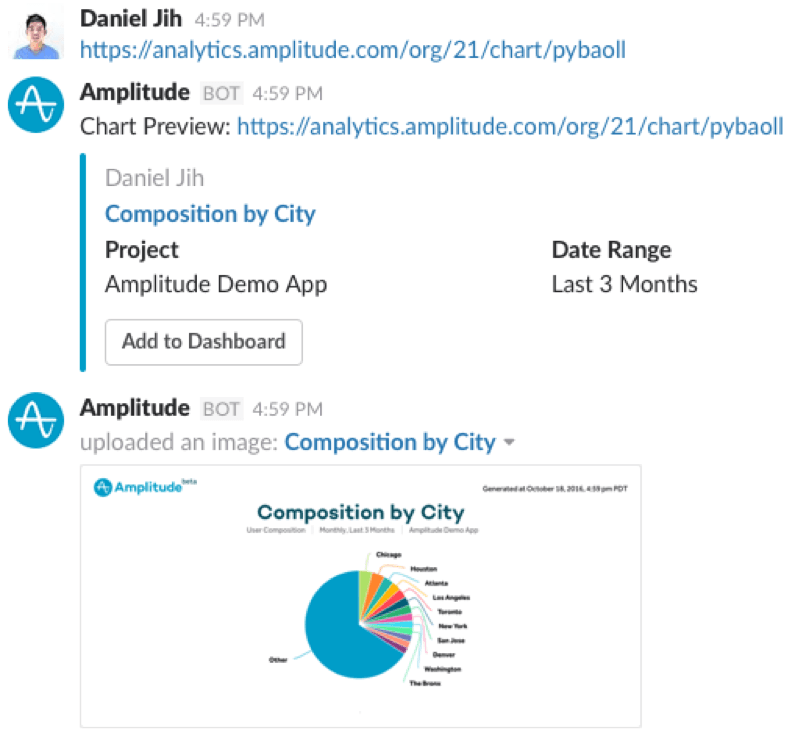Amplifying Global Change With the Slack/Amplitude Integration
How Change.org uses Slack’s integration with Amplitude to understand global trends and increase data literacy.
Today, we’re excited to announce Amplitude’s integration with Slack Enterprise Grid, enabling teams to communicate and collaborate better with data. Change.org, the world’s platform for petition starters and supporters, is using the Slack/Amplitude integration to increase data visibility and make better business decisions. Here’s their story…
At any given time, you can bet that there’s probably an experiment running on Change.org. Whether it’s focused on the specific words in a new customer acquisition campaign or the flow of a sign up funnel, the team that builds this global activist platform focuses on sussing out the best possible option and sharing that information quickly to the people who make decisions.

For the team at Change.org, this process depends on two things:
- the integration between Slack, their internal communication platform of choice, and Amplitude, their platform of choice for product and user behavior analytics.
- Alice Benziger.
Enabling better data literacy
Alice is a part of the data science team at Change.org. She and her colleagues are leading the charge for internal data literacy and communication at Change.org, one Slack message and Amplitude dashboard training at a time.
“We are getting there,” Alice said. “We’ve been doing data trainings and showing what’s out there and what’s possible with Amplitude.”
And one of the best ways to get the many internal teams comfortable using data in their day-to-day decisions, she said, is to use Slack.
“Change is a place where we use Slack a lot. We have a lot of channels, we are even deliberating on business decisions using Slack,” she said.
For her team, adding the integration with Amplitude analytics keeps the robust conversation between global teams streamlined and actionable.
“The best thing about the Amplitude and Slack integration is that whenever people have a question or are talking about a specific metric, one of the users can pull in an Amplitude report to Slack. People can quickly look at the data, understand the trends and talk about next steps right away without having to go back and forth between different tools.”

In this way, not everyone at Change.org has to be an Amplitude user or know how to create a report in order to benefit from the essential insights the platform provides.
Amplitude’s mission is to help businesses understand their users so that they can build better products. In other words, make analytics approachable to anyone, regardless of analytics experience, so that everyone on a team can access, explore, and learn from their user behavior data. The Amplitude team saw an integration with Slack Enterprise Grid as an essential step to help teams communicate more effectively and efficiently about data, and spur organizational transformation.
Efficient decision-making
For Alice and her colleagues, efficiency is the key benefit of using Amplitude with Slack. Before the Amplitude-Slack integration, her data science team would either send out a huge link that would take people out of Slack and into their previous analytics tool, or send screenshots of the chart themselves–additional steps that add up to a lot of time. Now, her team simply invites the Amplitude bot into channels and group messages as needed. When the bot detects that an Amplitude link has been shared it can post back a proper preview of the report.
Seeing Amplitude data instantly in Slack, Alice said, empowers her teammates – especially the product managers and country leads – to be more self sufficient than ever before while freeing up her time.
“The data science team can now focus on more long term impactful projects since we don’t have to be answering simple ad hoc questions every now and then.”
Want to learn more? You can read Amplitude’s blog post to get the details on how the Slack-Amplitude integration works and learn about Slack Enterprise Grid here.

Cara Harshman
Former Managing Editor, Amplitude
Cara was formerly the Managing Editor at Amplitude. Before joining this crew of super-passionate, smart individuals, she wrote and spoke a lot about A/B testing and personalization at Optimizely. She has spoken at MozCon, CTA Conference, Opticon, and Learn Inbound.
More from Cara




